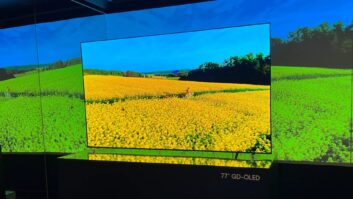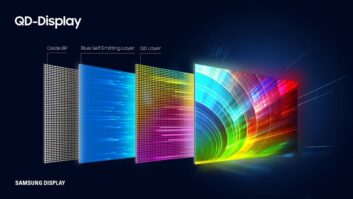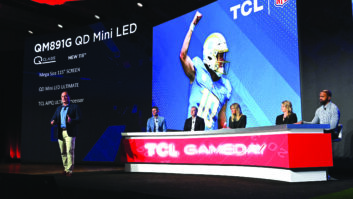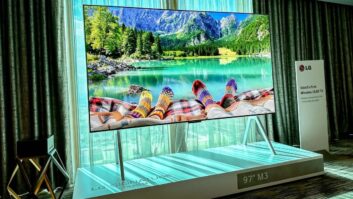
Editor’s Note: This article originally appeared on TechRadar.
Sharp reportedly revealed the future of TV display tech when it showed the first QDEL screen to a small group of CES 2024 attendees. As one of the few people to see it, Digital Trends says that mass production information, pricing and release dates are all being kept tight-lipped, but the announcement of the technology is exciting nonetheless.
But firstly, what is QDEL? No, it’s not a type of OLED or QLED, although it does use the same quantum-dot tech that QLED TVs use. QDEL stands for Quantum Dot Electroluminescent and although it uses the same quantum dots as QLED, the tech looks to differ in two specific ways.
While quantum dots typically absorb light from an energy source such as LED or OLED (typically blue light) and then convert this light into color, Digital Trends explains that QDEL screens receive energy via electricity directly to display color instead. This means that QDEL screens don’t need a separate light source.
QDEL screens also don’t use LED backlights or OLED to create color and brightness, meaning that the quantum dot itself is doing all of this on its own. Instead, QDEL has modified quantum dots, which are already microscopic in size, to have sub-pixels with dedicated red, blue and green colors. The idea is that by not having to rely on a backlight, you’ll likely get the most ‘pure’ image available.
As mentioned, Sharp made it clear, according to Digital Trends, that it has no concrete information as to when QDEL tech can be mass-produced into TVs. The QDEL screen shown at CES was reportedly a 12-inch display, but there was also a 30-inch display prototype, which Sharp showed off to prove that QDEL tech was scalable.
The other big claim that Sharp made was that, unlike OLED, QDEL’s manufacturing methods could be the same as regular LED, meaning we may not see an astronomical increase in prices if this new TV tech does eventually become available.
The future of TV tech?
What could this exciting QDEL tech mean for TVs? In theory, a QDEL TV would be able to achieve the perfect colors, contrast and black levels of an OLED without any of the drawbacks. For instance, because OLED is an organic material, it degrades over time, but with QDEL this wouldn’t be an issue as quantum dots are built to last (it’s the backlights in a TV that tend to go first). QDEL could in theory also be more self-sufficient in generating light and color, meaning it would be brighter and have more rich colors as well.
Although we already have plenty of display technologies – such as QD-OLED and microlens array (MLA) tech, which are both built-in to some of the best TVs on the market – they do still have their limitations. QD-OLED and MLA require additional layers to be added to a TV’s panel as they still inherently rely on a backlight or OLED materials, which eventually degrade and can suffer from burn-in.
If QDEL can make its way into TVs, it could bring a whole host of color and brightness-enhancing benefits with added longevity. Of course, this is all speculation as Sharp showed all this on a small display without any of the regular TV display components. Sharp even said, according to Digital Trends, that TVs may not be the first port of call, as QDEL tech could lend itself better to smartphones. But this is what CES is all about – exploring exciting new tech that we hope one day will find its way into our TVs.
About the Author
James Davidson is the TV Hardware Staff Writer at TechRadar. Before joining the team, he worked at a major UK-based AV retailer selling TV and audio equipment, where he was either telling customers the difference between OLED and QLED or being wowed by watching a PS5 run on the LG 65G2. When not writing about the latest TV tech, James can be found gaming, reading, watching rugby or coming up with another idea for a novel.
See also: CES 2024: Trends To Watch













